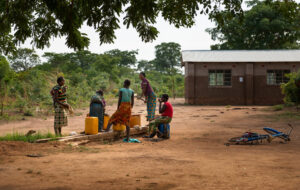- SIWI – Leading expert in water governance
- /
- Latest
- /
- Analysis of NDC enhancement: Increased role for water and water-related activities
Analysis of NDC enhancement: Increased role for water and water-related activities

The role that water and water-related activities play in national economies has been increasingly recognized in most Nationally Determined Contributions (NDCs).

In the first round of NDCs, water was regularly noted as a priority but this status was not always reflected through detailed activities, extensive measures or targets relating to water. In comparison, most enhanced NDCs include a wider range of sectors and measures that include water-related activities. In addition, more connections between the NDC and Sustainable Development Goals (SDGs) were made by most parties, including specific reference to SDG6 Clean Water and Sanitation were found in approximately 35 percent of NDCs.
Vulnerability
Most enhanced NDCs significantly increased their information and detail around vulnerabilities to climate change on national sectors including agriculture, energy, and urban areas, especially though impacts on water resources. Many also included measures related to flooding and drought. Most parties chose to include qualitative information on the likely effect of climate change on key sectors. This includes measures that specifically connected their commitments to climate change impact. This differs from the first NDC where it was more common to find generic activities. 30 percent of developing country NDCs included connections to Disaster Risk Reduction (DRR) and the Sendai Framework, although only a few covered DRR in extensive details. While 30 percent was an improvement compared with the earlier iteration, more works needs to be done around the response to climate change risks in NDCs.
Mitigation
As noted in the UNFCCC Synthesis report published in September 2021, all parties have included mitigation targets and mitigation co-benefits. Mitigation measures increasingly included water-related activities and an increased role in emissions reduction for ecosystems such as wetlands, peatlands, and mangroves in tropical localities. 60 percent of recent NDCs include such mitigation measures.
Wastewater measures recognition and commitments were also found in 60 percent of enhanced NDCs. Many recognized the emission reduction potential, but overall wastewater was considered important for both mitigation and adaptation targets and goals.
In contrast, it was very rare to find specific mitigation targets or activities for the water sector based on the pumping and distribution of water for uses. Several states noted that this source can be highly significant within various sectors such as agriculture and water supply, but any emissions considerations were generally included within electricity targets.
Water, Sanitation and Hygiene
There was also much higher consideration of water, sanitation, and hygiene (WASH) activities, especially compared with the first version of parties respective NDCs. Whilst water resource concerns were regularly recognized in the first NDC, there were not similar levels of attention around WASH. Following enhancement, approximately 45 percent contained measures around sanitation, including the management of solid waste for health and mitigation purposes. The numbers of parties that included WASH measures more than tripled compared with the first round of NDCs. This increase reflects a higher awareness of the connection between WASH and climate resilience and shows emerging concerns that WASH-related infrastructure is under threat from climate change.
Gender
The UNFCCC Synthesis report noted much more attention to the interactions between gender and climate change in the NDCs. This attention included more detail about specific vulnerabilities and risks as well as different gender-based assessment and activities. Similarly, enhanced NDCs also presented more detail about gender and water, including measures designed to reduce gender-connected water risks. There is a clear recognition that gender-based concerns need to be addressed within decision-making and overall governance processes.
Indigenous Peoples
Several parties included measures and activities including Indigenous Peoples, most notably in Latin America and South-East Asia. Overall, there were not many measures relating to indigenous peoples and water, but parties like Costa Rica chose indicators that help to understand the impact of climate change and climate change responses on Indigenous peoples. However, even where references to indigenous peoples were included it was very rarely in connection with governance, including water governance.
Other posts in the series
This blog post is part of a small series that looks at how water and water-related activities have been included within the most recent round of Nationally Determined Contributions (NDCs) prepared in the lead-up to COP26 in Glasgow, United Kingdom.

Analysis of NDC enhancement: Possible gaps
- Water and the 2030 Agenda
- Water and climate
- Transboundary Water Cooperation
- Water cooperation

Analysis of NDC enhancement: Integrative approaches
- Water and the 2030 Agenda
- Water governance
- Water and climate

Analysis of NDC enhancement: First impressions
- Water and the 2030 Agenda
- Water governance
- Water and climate

Analysis of NDC enhancement: Foundations
- Water and the 2030 Agenda
- Water and climate
- Indigenous knowledge
Most recent

SIWI joins Wallenberg-funded forest resilience research
- Freshwater and ecosystems/biodiversity
- Water and climate
- Water in landscapes

Forests, trees and the water cycle: why agriculture depends on healthy landscapes
- Agriculture and water
- Freshwater and ecosystems/biodiversity
- Water in landscapes

SIWI Reflections 2025: Shaping water resilience through European policy

SIWI Reflections 2025: When green water strengthens food security and resilience



